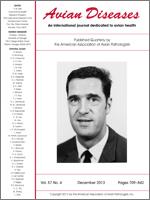This study was initiated to determine the persistence, distribution, and quantification of infectious bursal disease virus (IBDV) in lymphoid and nonlymphoid tissues of specific-pathogen-free (SPF) and commercial broiler chickens. Two serotype 1 strains, STC classic and IN variant, were independently used in the experiments. Five separate experiments were conducted using 2- and 4-wk-old SPF chickens, 2- and 4-wk-old in ovo–vaccinated commercial broilers, and 2-wk-old commercial broilers having maternally derived anti-IBDV antibodies. Pooled data from five experiments revealed that SPF chickens had a significantly higher incidence of IBDV-positive reverse transcriptase PCR (RT-PCR) results than commercial chickens (multivariable logistic regression, adjusted odds ratio = 15.28; 95% confidence limits [CL] = 9.53, 24.51, P < 0.0001). In many cases, the viral RNA (vRNA) persisted longer in in ovo–vaccinated commercial broilers bearing maternally derived antibodies compared with similar broilers not vaccinated in ovo. The STC strain was more frequently detected in tissues than the IN strain (chi-square P < 0.0001). In lymphoid tissues, STC and IN strains were detected for the longest duration in bursal tissues followed by spleen, thymus, and bone marrow. In nonlymphoid tissues, STC and IN strains were detected the longest in cecum followed by liver, kidney, pancreas, lungs, thigh, and breast muscles. Compared with bursal tissues, muscle and bone marrow tissues were significantly less likely to yield an IBDV-positive RT-PCR result (P < 0.0001). Although STC vRNA was detected up to 42 days postinoculation (DPI) in bursal homogenates of SPF chickens, virus isolation from bursal homogenates using embryonated chicken eggs was only possible up to 28 DPI. Similarly, STC vRNA was detected up to 42 DPI in bursal tissues of commercial broilers, but infectious virus could be isolated only up to 21 DPI. The IN strain was isolated up to 10 DPI from bursal homogenates of SPF chickens and broilers, but vRNA was detected up to 35 DPI in SPF chickens and 21 DPI in broilers. This study emphasizes that the detection of vRNA is not indicative of the presence of infectious virus, and virus isolation has to be performed to prove the presence of infectious virus.
Persistencia y distribución en los tejidos del virus de la enfermedad infecciosa de la bolsa en pollos de engorde comerciales y en aves libres de patógenos específicos infectados experimentalmente.
Se inició este estudio para determinar la persistencia , la distribución , y la cuantificación del virus de la enfermedad infecciosa de la bolsa (con las siglas en inglés IBDV) en los tejidos linfoides y no linfoides de pollos libres de patógenos específicos (con las siglas en inglés SPF) y en pollos de engorde comerciales. Se utilizaron de manera independiente en los estudios, dos cepas del serotipo 1, la cepa clásica STC y la cepa variante IN. Se realizaron cinco experimentos independientes utilizando a) pollos libres de patógenos específicos de dos y cuatro semanas de edad, b) pollos de engorde de dos y cuatro semanas de edad vacunados in ovo y c) pollos de engorde de dos semanas de edad con anticuerpos maternales contra el virus de Gumboro. Los datos agrupados de los cinco experimentos revelaron que los pollos libres de patógenos específicos tuvieron una mayor incidencia del virus de Gumboro demostrado por resultados positivos por RT-PCR en comparación con los pollos comerciales (regresión logística multivariable, razón de momios ajustada = 15.28; límites de confianza [IC] = 9.53, 24.51, P < 0.0001). En muchos casos, el ARN viral (ARNv) persistió más tiempo en los pollos de engorde comerciales vacunados in ovo que poseían anticuerpos maternales en comparación con los pollos de engorde similares no vacunados in ovo. La cepa STC se detectó con mayor





